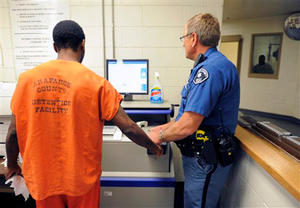Immigration mattersAll U.S. counties on Mexican border now share inmate fingerprints with feds
All 25 U.S. counties along the Mexican border are now enrolled in the Secure Communities project; federal immigration officials now have access to the prints of every inmate booked into jail in these counties; Secure Communities makes the notification automatic; Immigration and Customs Enforcement (ICE), which plans to implement the program nationwide by 2013, says the program has identified more than 262,900 illegal immigrants in jails and prisons who have been charged with or convicted of criminal offenses, including more than 39,000 charged with or convicted of violent offenses or major drug crimes; ICE expects to remove 400,000 illegal immigrants this year; of the 200,000 illegal immigrants deported in the first ten months of fiscal year 2010, 142,000 illegal immigrants were with criminal records and about 50,000 were noncriminals; immigrant advocates say that some counties use Secure Communities to deport noncriminals: the national average of noncriminals flagged by Secure Communities is about 28 percent, but in Travis County, Texas, 82 percent of those removed through Secure Communities were noncriminals

Sharing of fingerprints in the Secure Communities program has led to hundreds of thousands of deportations // Source: sanfranciscosentinel.com
U.S. Immigration officials now have access to the fingerprints of every inmate booked into jail in all twenty-five U.S. counties along the Mexican border, DHS secretary Janet Napolitano said Tuesday, saying the program was a way of identifying and deporting “criminal aliens.”
Napolitano’s announcement came as immigrant rights activists criticized the fingerprinting program, known as Secure Communities, after obtaining documents showing that more than a quarter of those deported under its auspices had no criminal records (“Fingerprint sharing through Secure Communities led to deportation of 47,000,” 10 August 2010 HSNW).
The program “essentially co-opts police into doing the job of the federal government,” said Sunita Patel of the Center for Constitutional Rights, one of several groups that forced the disclosure of documents through a Freedom of Information Act lawsuit. The Los Angeles Times’s Ken Dilanian quotes DHS officials to say that the charge is baseless.
Dilanian writes that Secure Communities gives Immigration and Customs Enforcement, or ICE, the ability to check the fingerprints of those arrested against a database that will show whether they have ever been deported or otherwise had contact with immigration agents. If the agency determines that the person is in the country illegally, federal agents can institute deportation proceedings. Records show that happens in some cases, but not all.
“The Secure Communities initiative reflects ICE’s ongoing commitment to smart, tough enforcement strategies that help ensure the apprehension of dangerous criminal aliens,” ICE director John Morton said. “Expediting removals decreases the amount of time these individuals spend in ICE custody — saving taxpayers money and strengthening public safety.”
By some estimates, as many as one million illegal immigrants now living in the United States have committed crimes, Morton has said. ICE is often unaware of them, even when they are in jail or prison.
Secure Communities makes notification automatic. ICE says the program has identified more than 262,900 illegal immigrants in jails and prisons who have been charged with or convicted of criminal offenses, including more than 39,000 charged with or convicted of violent offenses or major drug crimes.
DHS has expanded the initiative from 14 to 544 jurisdictions in the last eighteen months. Among the jurisdictions are Los Angeles and San Diego counties, as well as the counties encompassing Houston, Dallas, Phoenix, Miami, and Philadelphia. ICE plans to implement the program nationwide by 2013 (“Secure Communities to have greater impact than Arizona immigration law,” 2 August 2010 HSNW).
Dilanian notes that, overall, ICE expects to remove 400,000 illegal immigrants this year, a record. Although ICE says it focuses on deporting criminals, it continues to expel noncriminals, a practice that has drawn criticism from immigration rights advocates. Other critics say ICE is not tough enough.
In the first ten months of fiscal year 2010, 142,000 illegal immigrants with criminal records were deported, ICE said — a third more than in the same period of the prior year. About 50,000 noncriminals were removed.
Noncriminals can include those who have failed to show up for deportation hearings, those who recently crossed the border illegally, or those who reentered the country after deportation, ICE spokesman Richard Rocha said.
Some of the immigrants deemed to be criminals were convicted of minor crimes, such as disorderly conduct.
The documents obtained by the immigration rights groups show that a total of 47,000 people have been removed since 2008 after being flagged under the Secure Communities fingerprint matching program. Of those, about 28 percent were noncriminals. There were a total of 119,000 fingerprint matches, but a match does not automatically mean a person is subject to removal.
The advocates noted that in some counties the proportion of noncriminals removed through Secure Communities was much higher — 82 percent in Travis County, Texas, for example. “This indicates that police officers are picking up people on pretexts” to engineer their deportations, said Bridget Kessler of Yeshiva University’s Cardozo School of Law in New York.
A spokesman for the Travis County sheriff said the agency had a policy of not inquiring about the immigration status of its inmates.
A DHS official, speaking on condition of anonymity because he was discussing changes not yet announced, told Dilanian that the department was seeking changes to ensure a focus on serious criminals and not on those who commit minor offenses.
